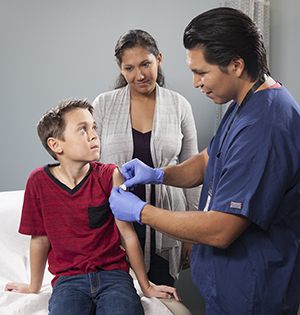Understanding Allergy Immunotherapy (Child)
Immunotherapy is a way to treat allergies. It helps your child’s body react less to the things that cause allergy symptoms. It's also known as desensitization, hyposensitization, or allergy shots. Your child's allergy or asthma healthcare provider will talk with you about the best treatment for your child.
How immunotherapy works

Immunotherapy is done to treat a child who has nasal allergies (allergic rhinitis) or asthma. A mixture is made from things they are allergic to. These may include pollens (grass, trees), mold spores, animal dander, bee venom, and house dust mites. This mixture is called an allergy extract. It works very much like a vaccine. It is given in the form of a shot (injection). Over time, higher and higher doses are given. Your child’s body becomes more used to the exposures. That way allergens in the environment cause less of a response. The shot has no medicine, such as antihistamines or steroids, in it.
Some types of immunotherapy may now be given under the tongue. This is called sublingual immunotherapy. The tablets or drops are placed daily under the tongue. They can be given at home. Not all insurance plans cover this form of immunotherapy.
Having immunotherapy
Immunotherapy is given by a shot into the fat in the back of the upper arm. It may not be as painful as a shot into a muscle, such as a flu shot. After your child has the shot, they may have some redness and swelling on the arm. Your child will need to stay in the healthcare provider's office for 30 minutes, or as directed, after each shot. This is to make sure your child doesn't have an allergic reaction. While reactions to allergy shots are not common, they can be severe and may need treatment right away.
Your child may have shots once or twice a week for up to a year. The dose and frequency of the allergy shots will change over time. When the maximum effective dose is reached, shots may be given less often. It may be every other week and then once a month, for example. Your child's healthcare provider will set a schedule for your child.
It can take from 12 to 18 months before your child’s allergy symptoms are better. Some children may start to feel better in 3 to 6 months. Your child may be treated for about 3 to 5 years. Once immunotherapy is stopped after 3 to 5 years, most children continue to feel the benefits for years after. Some healthcare providers will recommend that your child carry epinephrine after injections.
While your child is being treated
Immunotherapy is only part of the treatment plan for children with allergies. It takes time to work. So your child will need to keep taking allergy medicines as advised by their healthcare provider. It is also important to remove as many allergens—such as dust mites—as you can from your child’s environment.
When to call the healthcare provider
Call your child's healthcare provider right away if your child has symptoms, such as:
-
A red rash that may itch (hives)
-
Unexplained swelling of any parts of the body
-
Wheezing when they breathe
When to call 911
Call 911 if your child has these symptoms:
-
Trouble breathing
-
Tightness in the throat or trouble talking
-
Fainting or dizziness
-
Feeling of doom
-
Vomiting
-
Rapid heartbeat or very fast pulse
-
Abdominal pain (severe or increasing)
-
Blue, purple, or gray skin or lips
-
Seizure or rhythmic jerking